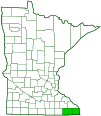long-styled black snakeroot
(Sanicula canadensis var. grandis)
Conservation • Wetland • Description • Habitat • Ecology • Use • Distribution • Taxonomy
Conservation Status |
|
|||||||
| IUCN Red List | not listed |
|||||||
| NatureServe | NNR - Unranked SNR - Unranked |
|||||||
| Minnesota | not listed |
|||||||
Wetland Indicator Status |
||||||||
| Great Plains | FACU - Facultative upland |
|||||||
| Midwest | FACU - Facultative upland |
|||||||
| Northcentral & Northeast | FACU - Facultative upland |
|||||||
Description |
||
Basal and lower stem leaves are palmately divided into 3 leaflets. The leaflets of these leaves are at least 3″ long and at least 1½″ wide. The lateral leaflets are often deeply cut making the leaf appear to have 5 leaflets — “3 looks like 5”. Rarely, there will be 5 leaflets with two deeply cut, looking like 7 leaflets. The flowers are white. There are only 2 to 7 flowers in each flower cluster. All umbellets include both perfect and male flowers. Perfect flowers are stalked. Male flowers are short-stalked and are concealed by the perfect flowers. The sepals are longer than the petals. The styles are inconspicuous, shorter than the bristles. The seed capsules are 1 ⁄16″ to 3 ⁄16″long. |
||
Height |
||
8″ to 40″ |
||
Flower Color |
||
White |
||
Similar Species |
||
The number of leaflets on the basal and lower stem leaves of black snakeroots (Sanicula spp.) is an important identifying feature. However, the lateral leaflets are often deeply lobed, often to the base, appearing to be two separate leaflets. Canadian black snakeroot (Sanicula canadensis var. canadensis) leaflets of the basal and lower stem leaves are less than 3″ long and less than 1½″ wide. Clustered black snakeroot (Sanicula odorata) basal and lower stem leaves are mostly 5-parted — “5 looks like 5”. The flowers are greenish-yellow. Some flower clusters have 3 perfect (containing both male and female parts) and 12 to 25 male flowers, others have all male flowers. The sepals are much shorter than the petals. The styles are conspicuous, much longer than the bristles. Large-fruited black snakeroot (Sanicula trifoliata) is much less common. Male flowers are long-stalked, rising above the perfect flowers. The styles are inconspicuous, shorter than the bristles. The seed capsules are ¼″ to 5 ⁄16″ long. The sepals in fruit converge, forming a beak as long or longer than the bristles. Maryland black snakeroot (Sanicula marilandica) basal and lower stem leaves are 5-parted with two deeply cut — “5 looks like 7”. The flowers are greenish-white. Some flower clusters have 3 perfect (containing both male and female parts) and 12 to 25 male flowers, others have all male flowers. Perfect flowers are stalkless. Male flowers are long-stalked, rising above the perfect flowers. The sepals are as long or only nearly as long as the petals. |
||
Habitat |
||
Moist to slightly dry woodlands; streambanks, prairie margins. Light to medium shade. |
||
Ecology |
||
Flowering |
||
June to August |
||
Pests and Diseases |
||
|
||
Use |
||
|
||
Distribution |
||||
|
Sources |
|||
| 3/25/2023 | ||||
Nativity |
||||
Native |
||||
Occurrence |
||||
Rare |
||||
Taxonomy |
|||
| Kingdom | Plantae (green algae and land plants) | ||
| Subkingdom | Viridiplantae (green plants) | ||
| Infrakingdom | Streptophyta (land plants and green algae) | ||
| Superdivision | Embryophyta (land plants) | ||
| Division | Tracheophyta (vascular plants) | ||
| Subdivision | Spermatophytina (seed plants) | ||
| Class | Magnoliopsida (flowering plants) | ||
| Superorder | Asteranae | ||
Order |
Apiales (carrots, ivies, and allies) | ||
| Suborder | Apiineae | ||
Family |
Apiaceae (carrot) | ||
| Subfamily | Saniculoideae | ||
| Tribe | Saniculeae | ||
Genus |
Sanicula (sanicles) | ||
| Species | Sanicula canadensis (Canadian black snakeroot) | ||
Subfamily |
|||
Synonyms |
|||
Sanicula floridana Sanicula canadensis var. floridana Sanicula canadensis var. typica |
|||
Common Names |
|||
Canadian black snakeroot Canadian black-snakeroot Canadian blacksnakeroot long-styled black snakeroot long-styled Canadian sanicle |
|||
The varietal epithet grandis refers to the size of the fruit, which is significantly larger in var. grandis than in var. canadensis. |
|||
Glossary
Palmate
Similar to a hand. Having more than three lobes or leaflets that radiate from a single point at the base of the leaf.
Perfect
Referring to a flower that has both male and female reproductive organs.
Pistillate
Referring to a flower that has a female reproductive organ (pistil) but does not have male reproductive organs (stamens).
Sepal
An outer floral leaf, usually green but sometimes colored, at the base of a flower.
Style
On plants: Part of the pistil, usually a slender stalk, connecting the ovary to the stigma(s). On flies (Diptera): A terminal, often slender or pointed, appendage arising from the end of the last, usually third, antennal segment.
Visitor Photos |
|||||
Share your photo of this plant. |
|||||
| This button not working for you? Simply email us at info@MinnesotaSeasons.com. Attach one or more photos and, if you like, a caption. |
|||||
|
|||||
MinnesotaSeasons.com Photos |
|||||
|
|||||

Slideshows |
||

Visitor Videos |
|||
Share your video of this plant. |
|||
| This button not working for you? Simply email us at info@MinnesotaSeasons.com. Attach a video, a YouTube link, or a cloud storage link. |
|||
Other Videos |
|||

Visitor Sightings |
|||||
Report a sighting of this plant. |
|||||
| This button not working for you? Simply email us at info@MinnesotaSeasons.com. Be sure to include a location. |
|||||
|
|||||
MinnesotaSeasons.com Sightings |
|||||
|
|||||

|
Created: Last Updated: © MinnesotaSeasons.com. All rights reserved. |
